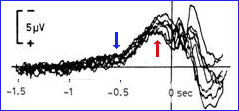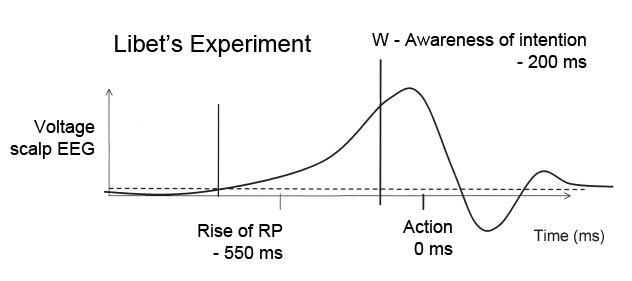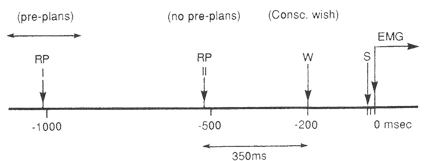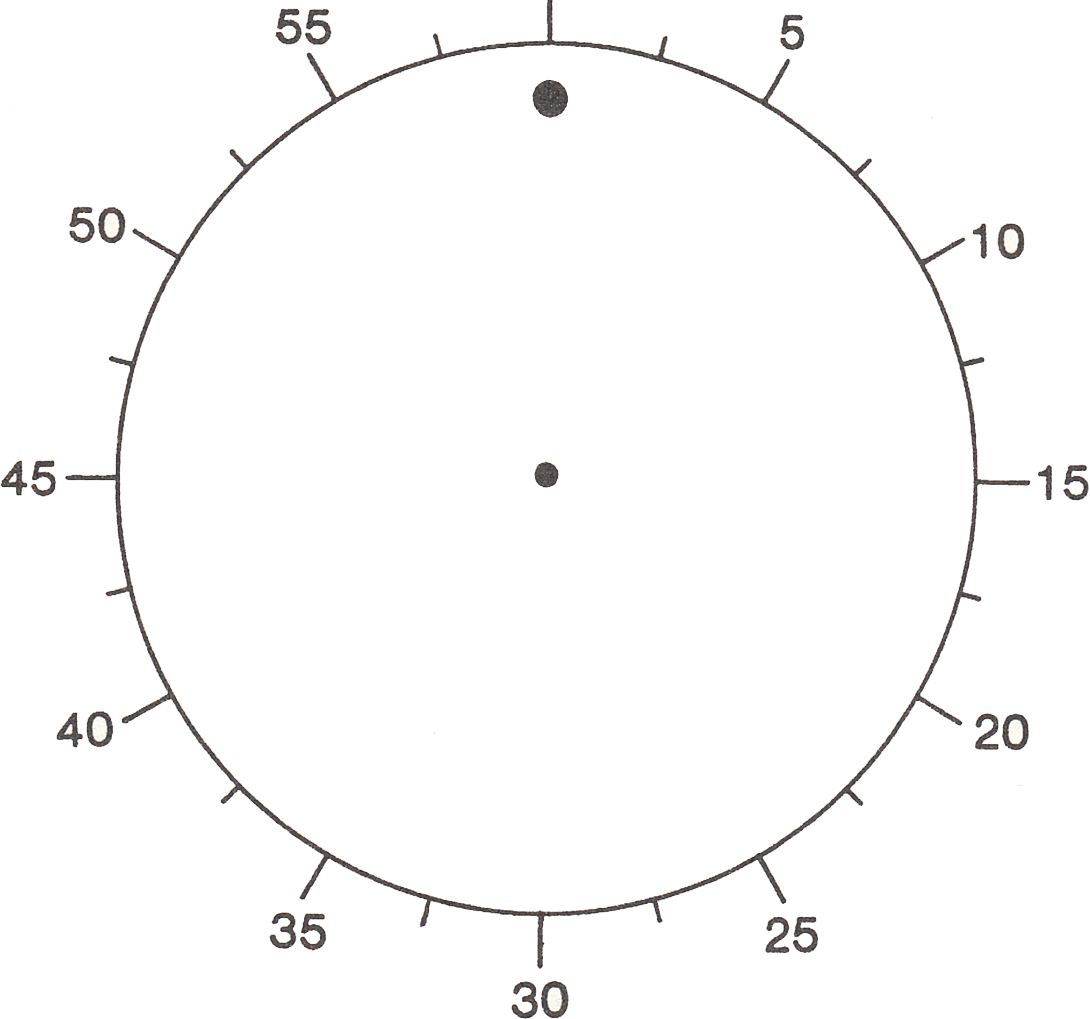The neurologist
Benjamin Libet performed a sequence of remarkable experiments in the early 1980's that were enthusiastically, if mistakenly, adopted by determinists and compatibilists to show that human free will does not exist.
His measurements of the time before a subject is aware of self-initiated actions have had a enormous, mostly negative, impact on the case for human free will, despite Libet's view that his work does nothing to deny human freedom.
Since free will is best understood as a complex idea combining two antagonistic concepts - freedom and determination,
"free" and "will," in a temporal sequence, Libet's work on the timing of events can also be interpreted as supporting our "
two-stage model" of free will.
Indeed, Libet himself argued that there was still room for a veto over a decision that may have been made unconsciously over 300 milliseconds before the agent is consciously aware of the decision to flex a finger, but before the action of muscles flexing. In his 2004 book,
Mind Time: The Temporal Factor in Consciousness, he presented a diagram of his work.
Fig. 4.3. Diagram of sequence of events, cerebral (RPs) and subjective (W), that precede a self-initiated voluntary act.
Relative to "0" time (muscle activation), cerebral RPs begin first, either with preplanned acts (RP I) or with no preplannings (RP II). Subjective experience of earliest awareness of the wish to move (W) appears at about -200 msec; this is well before the act ("0" time) but is some 350 msec after even RP II. Subjective timings of the skin stimulus (S) averaged about —50 msec, before the actual stimulus delivery time.
Libet says the diagram shows room for a "conscious veto."
The finding that the volitional process is initiated unconsciously leads to the question: Is there then any role for conscious will in the performance of a voluntary act (Libet, 1985)? The conscious will (W) does appear 150 msec before the motor act, even though it follows the onset of the cerebral action (1W) by at least 400 msec. That allows it, potentially, to affect or control the final outcome of the volitional process. An interval msec before a muscle is activated is the time for the primary motor cortex to activate the spinal motor nerve cells, and through them, the muscles. During this final 5o msec, the act goes to completion with no possibility of its being stopped by the rest of the cerebral cortex.)
The conscious will could decide to allow the volitional process to go to completion, resulting in the motor act itself. Or, the conscious will could block or "veto" the process, so that no motor act occurs.

The original discovery that an electrical potential (of just a few microvolts - μV) is visible in the brain long before the subject flexes a finger was made by Kornhuber and Deecke (1964). They called it a "
Bereitschaftspotential" or readiness potential.
As shown on Kornhuber's RP diagram, the rise in the readiness potential was clearly visible at about 550 milliseconds before the flex of the wrist (blue arrow).
The neurobiologist
John Eccles speculated that the subject must become conscious of the
intention to act before the onset of this readiness potential. Libet had the idea that he should test Eccles's prediction.
Libet's 1983 experiments measured the time when the subject became consciously aware of the decision to move the finger. Libet created a dot on the screen of an oscilloscope circulating like the hand of a clock, but more rapidly. The subject was asked to note the position of the moving dot when he/she was aware of the conscious decision to move a finger or wrist.
Libet found that although conscious awareness of the decision preceded the subject's finger motion by only 200 milliseconds, the rise in the Type II readiness potential was clearly visible at about 550 milliseconds before the flex of the wrist. The subject showed
unconscious activity to flex about 350 milliseconds before reporting
conscious awareness of the decision to flex (the red arrow above). Indeed an earlier slow and very slight rise in the readiness potential can be seen as early as 1.5 seconds before the action.

Libet's results were eagerly adopted by the deniers of free will to indicate that the mind had been made up unconsciously, long before any awareness of "conscious will."
Psychologist
Daniel Wegner thinks that conscious will may be just an
epiphenomenon, something that is caused by brain events, not the cause of such events. As he put it in his 2002 book
The Illusion of Conscious Will,
We don't know what specific unconscious mental processes the RP might represent....The position of conscious will in the time line suggests perhaps that the experience of will is a link in a causal chain leading to action, but in fact it might not even be that. It might just be a loose end — one of those things, like the action, that is caused by prior brain and mental events.
(The Illusion of Conscious Will, MIT Press, p.55)
Does the compass steer the ship? In some sense, you could say that it does, because the pilot makes reference to the compass in determining whether adjustments should be made to the ship's course. If it looks as though the ship is headed west into the rocky shore, a calamity can be avoided with a turn north into the harbor. But, of course, the compass does not steer the ship in any physical sense. The needle is just gliding around in the compass housing, doing no actual steering at all. It is thus tempting to relegate the little magnetic pointer to the class of epiphenomena — things that don't really matter in determining where the ship will go.
Conscious will is the mind's compass. As we have seen, the experience of consciously willing action occurs as the result of an interpretive system, a course-sensing mechanism that examines the relations between our thoughts and actions and responds with "I willed this" when the two correspond appropriately. This experience thus serves as a kind of compass, alerting the conscious mind when actions occur that are likely to be the result of one's own agency. The experience of will is therefore an indicator, one of those gauges on the control panel to which we refer as we steer. Like a compass reading, the feeling of doing tells us something about the operation of the ship. But also like a compass reading, this information must be understood as a conscious experience, a candidate for the dreaded "epiphenomenon" label.
(The Illusion of Conscious Will, MIT Press, p.317)
Bernard Baars says there are two important time scales of consciousness
Sensory events occurring within a tenth of a second merge into a single conscious sensory experience, suggesting a 100-millisecond scale. But working memory, the domain in which we talk to ourselves or use our visual imagination, stretches out over roughly 10-second steps. The tenth-of-a-second level is automatic, while the 10-second level is shaped by conscious plans and goals.
(In the Theater of Consciousness, p.48)
The kinds of deliberative and evaluative processes that are important for
free will involve longer time periods than those studied by Benjamin Libet.
Note also that the abrupt and rapid decisions to flex a finger measured by Libet bear little resemblance to the kinds of
two-stage deliberate decisions for which we can first
freely generate alternative possibilities for action, then evaluate which is the best of these possibilities in the light of our reasons, motives, and desires -
first "free," then "will."
We can correlate the beginnings of the readiness potential (350ms before Libet's conscious will time "W" appears) with the early stage of the two-stage model, when alternative possibilities are being generated, in part at random. The early stage may be delegated to the subconscious, which is capable of considering multiple alternatives (
William James' "blooming, buzzing confusion") that would congest the single stream of consciousness.
Alfred Mele, in his 2009 book
Effective Intentions, the Power of Conscious Will, criticized the interpretation of the Libet results on two grounds. First, the mere appearance of the RP a half-second or more before the action in no way makes the RP the
cause of the action. It may simply mark the beginning of forming an
intention to act. In our two-stage model, it is the considering of possible options.
Libet himself argued that there is enough time after the W moment (a window of opportunity) to
veto the action, but Mele's second criticism points out that such examples of "free won't" would not be captured in Libet experiments, because the recording device is triggered by the action (typically flicking the wrist) itself.
Thus, although all Libet experiments ended with the wrist flicking, we are not justified in assuming that the rise of the RP (well before the moment of conscious will) is a
cause of the wrist flicking. Libet knew that there were very likely other times when the RP rose, but which did not lead to a flick of the wrist.
Thinkers (e.g.,
Daniel Wegner,
Patrick Haggard) who claim that the Libet experiments prove that our conscious will and subsequent actions are
caused by prior neural activity - the popular view that "my neurons made me do it" - are simply wrong.
Many philosophers have called free will "unintelligible" because of the internal contradiction and the presumed simultaneity and identity of free and will. Specifically, they mistakenly have assumed that "free" is a time-independent adjective modifying "will."
A careful examination of ordinary language usage shows that free will is actually a
temporal sequence of two opposing concepts - first "free" and then "will."
First comes the consideration of
alternative possibilities, which are generated unpredictably by acausal events (simply noise in neural network communications). This free creation of possible thoughts and actions allow one to feel "
I can do otherwise."
Next comes
de-liberation and determination by the will, the unfreeing of possibilities into actuality, the decision that directs the tongue or body to speak or act.
After the deliberation of the will, the true sentence "
I can do otherwise" can be changed to the past tense and remain true as a "hard fact" in the "fixed past," and written "
I could have done otherwise."
Thus we have the
temporal sequence which
William James saw so clearly well over a century ago, with chance in a
present time of random alternatives, leading to a choice which grants consent to one possibility and transforms an equivocal future into an inalterable and
simple past.
Free undetermined alternatives are followed by
willed, determined choices. As
John Locke knew more than three hundred years ago, "free" is an adjective that describes not the will, but the human mind.


 Libet's results were eagerly adopted by the deniers of free will to indicate that the mind had been made up unconsciously, long before any awareness of "conscious will."
Psychologist Daniel Wegner thinks that conscious will may be just an epiphenomenon, something that is caused by brain events, not the cause of such events. As he put it in his 2002 book The Illusion of Conscious Will,
Libet's results were eagerly adopted by the deniers of free will to indicate that the mind had been made up unconsciously, long before any awareness of "conscious will."
Psychologist Daniel Wegner thinks that conscious will may be just an epiphenomenon, something that is caused by brain events, not the cause of such events. As he put it in his 2002 book The Illusion of Conscious Will,




